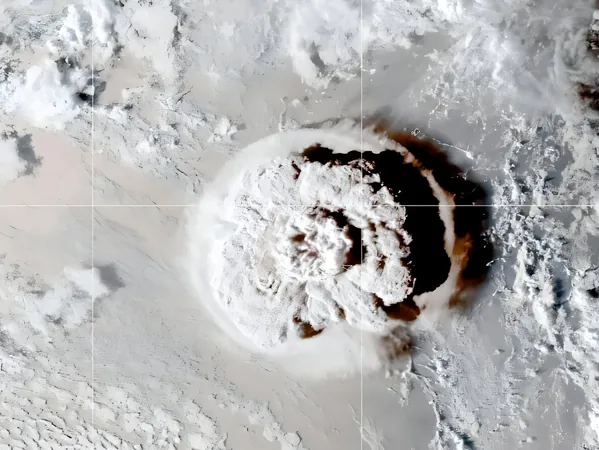
Catastrophic Volcano Eruption Buries Underwater Life: A Deep Dive into the Fallout
2025-07-08
Author: Arjun
In an unprecedented geological event, the Hunga volcano erupted underwater in 2022, launching a plume of ash an astounding 37 miles high—the largest ever recorded by satellites. This explosive activity not only reshaped the sky but also provided researchers a rare window into the impacts on the ocean floor.
Months later, a research team from the University of Oregon, alongside experts from the University of Rhode Island and Western Washington University, embarked on an exploration mission. Onboard, undergraduate student Marcus Chaknova made a shocking discovery: thick layers of volcanic ash blanketing the seafloor, suffocating delicate deep-sea ecosystems.
A Rare Opportunity for Research
"This was a once-in-a-lifetime chance," Chaknova remarked, highlighting the rarity of observing underwater sediment movements. Now a graduate student in Earth Sciences, he led a project investigating the aftermath of the eruption.
Chaknova collaborated with 16 global experts, including Professor Thomas Giachetti, becoming the lead author of a pivotal study on the ash's journey and its devastating effects on marine life.
Tracing the Path of Destruction
Confirming the ash’s origin from the Hunga volcano—about 40 miles from Tonga—was the first step. After an eruption, ash takes weeks, sometimes months, to settle onto the ocean floor, driven by winds and currents.
Chaknova’s lab work matched ash samples found on the seabed with those near the volcano, revealing layers thicker than a meter in places, predominantly composed of fine particles.
Investigating Underwater Avalanches
Chaknova deduced that much of the ash originated from the volcano’s caldera walls, propelled by powerful underwater flows that resembled avalanches. These flows, so intense, disrupted submarine cables and even carved canyons into the ocean floor.
By analyzing the timing of power outages caused by these disruptions, researchers estimated how swiftly the ash moved across the seabed, setting the stage for simulations of its dispersion.
Ecological Devastation Unfolds
The eruption's fallout was not merely geological; it wreaked havoc on entire ecosystems. In the dark depths of the ocean, where sunlight cannot penetrate, organisms depend on chemosynthesis to survive—a stark contrast to surface life.
With an estimated 90% of marine life residing on the seafloor, the volcanic eruption buried countless creatures under layers of ash. While some can endure brief episodes of burial, this sudden influx of ash proved catastrophic.
"Suspension feeders are critical in this environment, relying on filtering food from the water. The ash clogged their gills and intestines, dramatically hindering their energy production," explained Chaknova.
Hidden Consequences for Local Communities
Interestingly, Chaknova's findings indicated that ash reached Tonga's coral reefs, initially prompting a short-lived bloom of plankton. However, once the ash settled, it began threatening coral ecosystems, crucial for larger marine species.
For Tonga, the volcano’s eruption posed serious consequences for livelihoods. The World Bank reports that around 82% of households depend on reef fishing for income, while marine tourism contributes over 7% to the nation's GDP.
"The eruption affected more than just power or Wi-Fi disruptions. For many, fishing is vital for food and economic security," Chaknova emphasized.
A Cautionary Tale for Future Mining
This study also raises critical alarms amid rising interest in deep-sea mining for metals like copper and cobalt, which lie beneath the ocean floor. Private companies have approached Pacific nations, including Tonga, to explore mining opportunities.
"The area we studied is mineral-rich, and many companies are eyeing it for bids on deep-sea mining projects," Chaknova revealed. While actual mining hasn’t commenced, researchers caution that sediment plumes from mining operations could mirror the detrimental effects of volcanic eruptions.
Chaknova's research stands out as one of the few sources of real-world data on the potential impacts of such disturbances, urging scientists and policymakers to comprehend the stakes involved.
The study was published in the esteemed journal Geochemistry, Geophysics, Geosystems, shedding light on a disaster that extended far beyond the underwater realm.


 Brasil (PT)
Brasil (PT)
 Canada (EN)
Canada (EN)
 Chile (ES)
Chile (ES)
 Česko (CS)
Česko (CS)
 대한민국 (KO)
대한민국 (KO)
 España (ES)
España (ES)
 France (FR)
France (FR)
 Hong Kong (EN)
Hong Kong (EN)
 Italia (IT)
Italia (IT)
 日本 (JA)
日本 (JA)
 Magyarország (HU)
Magyarország (HU)
 Norge (NO)
Norge (NO)
 Polska (PL)
Polska (PL)
 Schweiz (DE)
Schweiz (DE)
 Singapore (EN)
Singapore (EN)
 Sverige (SV)
Sverige (SV)
 Suomi (FI)
Suomi (FI)
 Türkiye (TR)
Türkiye (TR)
 الإمارات العربية المتحدة (AR)
الإمارات العربية المتحدة (AR)